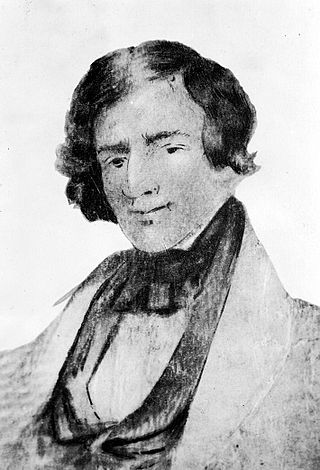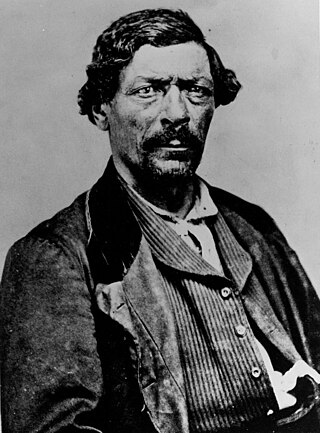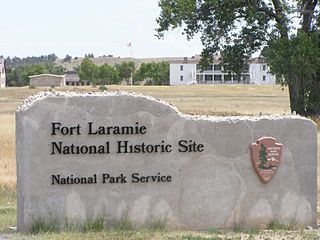
Jedediah Strong Smith was an American clerk, transcontinental pioneer, frontiersman, hunter, trapper, author, cartographer, mountain man and explorer of the Rocky Mountains, the Western United States, and the Southwest during the early 19th century. After 75 years of obscurity following his death, Smith was rediscovered as the American whose explorations led to the use of the 20-mile (32 km)-wide South Pass as the dominant route across the Continental Divide for pioneers on the Oregon Trail.

A mountain man is an explorer who lives in the wilderness and makes his living from hunting and trapping. Mountain men were most common in the North American Rocky Mountains from about 1810 through to the 1880s. They were instrumental in opening up the various emigrant trails allowing Americans in the east to settle the new territories of the far west by organized wagon trains traveling over roads explored and in many cases, physically improved by the mountain men and the big fur companies, originally to serve the mule train-based inland fur trade.

The North Platte River is a major tributary of the Platte River and is approximately 716 miles (1,152 km) long, counting its many curves. In a straight line, it travels about 550 miles (890 km), along its course through the U.S. states of Colorado, Wyoming, and Nebraska.

The Sweetwater River is a 238-mile (383 km) long tributary of the North Platte River, in the U.S. state of Wyoming. As a part of the Mississippi River system, its waters eventually reach the Gulf of Mexico.

James Pierson Beckwourth was an American fur trapper, rancher, businessman, explorer, author and scout. Known as "Bloody Arm" because of his skill as a fighter, Beckwourth was of multiracial descent, being born into slavery in Frederick County, Virginia. He was eventually emancipated by his enslaver, who was also his father, and apprenticed to a blacksmith so that he could learn a trade.

Fort Laramie was a significant 19th-century trading post, diplomatic site, and military installation located at the confluence of the Laramie and the North Platte Rivers. They joined in the upper Platte River Valley in the eastern part of the present-day U.S. state of Wyoming. The fort was founded as a private trading-post in the 1830s to service the overland fur trade; in 1849, it was purchased by the United States Army. The site was located east of the long climb leading to the best and lowest crossing-point over the Rocky Mountains at South Pass and became a popular stopping-point for migrants on the Oregon Trail. Along with Bent's Fort on the Arkansas River, the trading post and its supporting industries and businesses were the most significant economic hub of commerce in the region.
William Henry Ashley was an American miner, land speculator, manufacturer, territorial militia general, politician, frontiersman, fur trader, entrepreneur, hunter, and slave owner. Ashley was best known for being the co-owner with Andrew Henry of the highly-successful Rocky Mountain Fur Incorporated, otherwise known as "Ashley's Hundred" for the famous mountain men working for the firm from 1822 to 1834.
David Edward “Davey” Jackson was an American pioneer, trapper, fur trader, and explorer.
The enterprise that eventually came to be known as the Rocky Mountain Fur Company was established in St. Louis, Missouri, in 1822 by William Henry Ashley and Andrew Henry. Among the original employees, known as "Ashley's Hundred," were Jedediah Smith, who went on to take a leading role in the company's operations, and Jim Bridger, who was among those who bought out Smith and his partners in 1830. It was Bridger and his partners who gave the enterprise the name "Rocky Mountain Fur Company."

Jacques La Ramée was a French-Canadian and Métis coureur des bois, frontiersman, trapper, fur trader, hunter, explorer, and mountain man who lived in what is now the U.S. state of Wyoming, having settled there in 1815. His name appears in several spellings, including La Ramee, Laramée, LaRamée, La Ramie, La Rami, La Remy, and Laramie. La Ramée is credited as an early explorer of what is now called the Laramie River of Wyoming and Colorado. The city of Laramie, Wyoming, with an Americanized spelling, was later named for him.

William Lewis Sublette, also spelled Sublett, was an American frontiersman, trapper, fur trader, explorer, and mountain man. After 1823, he became an agent of the Rocky Mountain Fur Company, along with his four brothers. Later he became one of the company's co-owners, utilizing the riches of the Oregon Country. He helped settle and improve the best routes for migrants along the Oregon Trail.

Thomas Fitzpatrick was an American-American fur trader, Indian agent, and mountain man. He trapped for the Rocky Mountain Fur Company and the American Fur Company. He was among the first white men to discover South Pass, Wyoming. In 1831, he found and took in a lost Arapaho boy, Friday, who he had schooled in St. Louis, Missouri; Friday became a noted interpreter and peacemaker and leader of a band of Northern Arapaho.

Pierre's Hole is a shallow valley in the western United States in eastern Idaho, just west of the Teton Range in Wyoming. At an elevation over 6,000 feet (1,830 m) above sea level, it collects the headwaters of the Teton River, and was a strategic center of the fur trade of the northern Rocky Mountains. The nearby Jackson's Hole area in Wyoming is on the opposite side of the Tetons.
Milton Green Sublette, was an American frontiersman, trapper, fur trader, explorer, and mountain man. He was the second of five Sublette brothers prominent in the western fur trade; William, Andrew, and Solomon. Milton was one of five men who formed the Rocky Mountain Fur Company to buy out the investment of his brother William L. Sublette, Jedediah S. Smith and Dave E. Jackson.
Antoine Godin, was "an Iroquois half-breed" Canadian fur trapper and explorer, is noted primarily for the public murder of a Gros Ventre chief which led to a battle between fur traders and Indians in Pierre's Hole, now called the Teton Basin, in eastern Idaho.
John Henry Weber (1779–1859) was an American fur trader and explorer. Weber was active in the early years of the fur trade, exploring territory in the Rocky Mountains and areas in the current state of Utah. The Weber River, Weber State University, and Weber County, Utah were named for Weber.

The fur trade in Montana was a major period in the area's economic history from about 1800 to the 1850s. It also represents the initial meeting of cultures between indigenous peoples and those of European ancestry. British and Canadian traders approached the area from the north and northeast focusing on trading with the indigenous people, who often did the trapping of beavers and other animals themselves. American traders moved gradually up the Missouri River seeking to beat British and Canadian traders to the profitable Upper Missouri River region.
Hiram Scott (1805–1828) was an American mountain man, trapper, and pelt trader who trapped and took part in expeditions throughout the western United States during the 1820s. Born in Missouri, Scott joined the Rocky Mountain Fur Company in 1822 and took part in the first fur trade expedition at the Great Salt Lake in Utah. He died at age 23 near a cliff along the North Platte River in Nebraska which was named in his honor. The circumstances leading to his demise have given rise to many diverse accounts and theories.

Moses Harris, also known as Black Harris, was a trapper, scout, guide, and mountain man. He participated in expeditions across the Continental Divide and to the Pacific Ocean through the Rocky and Cascade Mountains. He rescued westward-bound pioneers. Harris spoke the Shoshoni language.

Joseph Bijeau, also known as Joseph Bijeau dit Bissonet and Joseph Bissonet, was among the earliest fur trappers of the Rocky Mountains. He was a guide for Stephen Harriman Long's expedition of the Great Plains in 1820. A fur trapper and hunter, he lived among the Pawnee people. He was able to communicate to a number of Native American tribes through his use of sign language as well as the Crow language, which was used among a number of western tribes. After Spain lost the Mexican territory, trappers like Bijeau moved to Taos where they could trap, trade, and travel east without the hostilities that they experienced in the western United States.














